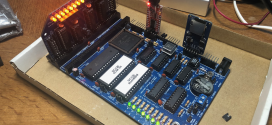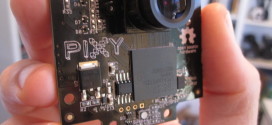 For the longest time I’ve been meaning to do something with the RAMTRON FM24V10 chips that I got as a sample some time last year. They’re I2C EEPROM drop-in replacements, meaning they are functionally and electrically identical to the standard ones we see everywhere. Their main advantage over standard I2C EEPROM chips is that you don’t have the 5ms delay after each write operation. Seeing as the NXT can only write 16 bytes per transaction, that adds up to quite a lot of “down time” between writes. Without the 5ms delay, you’ll get close to 1KB/s instead of about 750B/s at the standard 9600Hz clock speed.
For the longest time I’ve been meaning to do something with the RAMTRON FM24V10 chips that I got as a sample some time last year. They’re I2C EEPROM drop-in replacements, meaning they are functionally and electrically identical to the standard ones we see everywhere. Their main advantage over standard I2C EEPROM chips is that you don’t have the 5ms delay after each write operation. Seeing as the NXT can only write 16 bytes per transaction, that adds up to quite a lot of “down time” between writes. Without the 5ms delay, you’ll get close to 1KB/s instead of about 750B/s at the standard 9600Hz clock speed.
The only trouble is they don’t come in a handy DIP-8 package. In fact it’s fair to say that they come in a very, very small package, the samples I received are SOIC-8. So they measure no more than 4x5mm. I took a picture of one of them next to one of those Technic LEGO half-pins so you can see just how tiny they are.
 I had to make an adapter to make it usable on a breadboard, so I took a DIP-8 socket, put a dab of hot glue in the middle and stuck the little guy on top. Before I could do that, though, I had to carefully bend all its legs outward and away from each other. That took quite a bit of careful bending and prodding.
I had to make an adapter to make it usable on a breadboard, so I took a DIP-8 socket, put a dab of hot glue in the middle and stuck the little guy on top. Before I could do that, though, I had to carefully bend all its legs outward and away from each other. That took quite a bit of careful bending and prodding.
I used some wires to go from the sockets to the chip legs and with the help of a magnifying glass and my steady hands I managed to get all of them soldered to the socket. It’s not going to win any beauty prizes but it will do the job.
Now the hard part starts. These chips run on 1V8-3V6 so I am going to have add some additional components before I can interface it with the NXT. I have a couple of the SparkFun logic level converters which I might use for this. The alternative is to use 3V3 and reduce the size of the pull-ups to 47KOhm instead of 82K. We’ll see how it goes.
 Bot Bench I'd Rather Be Building Robots
Bot Bench I'd Rather Be Building Robots




Embedded Adventures sells some bi-directional level translators that they say work well with I2C. That may be a possible solution.